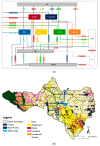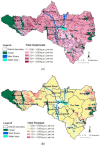Application Intensity and Spatial Distribution of Three Major Herbicides from Agricultural and Nonagricultural Practices in the Central Plain of Thailand
- PMID: 33809586
- PMCID: PMC8002346
- DOI: 10.3390/ijerph18063046
Application Intensity and Spatial Distribution of Three Major Herbicides from Agricultural and Nonagricultural Practices in the Central Plain of Thailand
Abstract
The herbicides glyphosate, paraquat, and 2,4-D play a significant role in Thailand. This paper is among the first study to describe the intensity of herbicide application and illustrate how the herbicides are extensively distributed over a large area through both agricultural and nonagricultural practices. Using a quick, economical, and simplified method of Material Flow Analysis together with spatial analysis, better data for the analysis of possible environmental herbicide contamination, human exposure, and related health risks for the general public and applicators can be developed. The findings from this study showed that in the study province, about 2.2 million kg of the active ingredients from the three targeted herbicides is applied annually. Pathway flow modeling with spatial analysis identified several local hotspots of concern based on the type of herbicide and crop/activity where it was used. Cassava planting was found to have the highest herbicide application activity, whereas rice cultivation was the major contributor of total herbicide mass, due to the wide area of cultivation in the province. The herbicide most likely to be applied at rates higher than recommended was 2,4-D, particularly on cassava and sugarcane farms.
Keywords: 2,4-D; Thailand; agriculture; environmental contamination; glyphosate; health risk; herbicide; non-agriculture; paraquat.
Conflict of interest statement
The authors declare no conflict of interest.
Figures








Similar articles
-
Glyphosate and Paraquat in Maternal and Fetal Serums in Thai Women.J Agromedicine. 2017;22(3):282-289. doi: 10.1080/1059924X.2017.1319315. J Agromedicine. 2017. PMID: 28422580
-
Filamentous fungi with high paraquat-degrading activity isolated from contaminated agricultural soils in northern Thailand.Lett Appl Microbiol. 2021 Apr;72(4):467-475. doi: 10.1111/lam.13439. Epub 2020 Dec 30. Lett Appl Microbiol. 2021. PMID: 33305426
-
Soil degradation and herbicide pollution by repeated cassava monoculture within Thailand's conservation region.PLoS One. 2024 Aug 6;19(8):e0308284. doi: 10.1371/journal.pone.0308284. eCollection 2024. PLoS One. 2024. PMID: 39106244 Free PMC article.
-
Herbicide resistance and biodiversity: agronomic and environmental aspects of genetically modified herbicide-resistant plants.Environ Sci Eur. 2017;29(1):5. doi: 10.1186/s12302-016-0100-y. Epub 2017 Jan 21. Environ Sci Eur. 2017. PMID: 28163993 Free PMC article. Review.
-
Paraquat and sustainable agriculture.Pest Manag Sci. 2004 Apr;60(4):340-9. doi: 10.1002/ps.823. Pest Manag Sci. 2004. PMID: 15119596 Review.
Cited by
-
Valorization of Nam Wah Banana (Musa paradisiaca L.) Byproducts as a Source of Bioactive Compounds with Antioxidant and Anti-inflammatory Properties: In Vitro and In Silico Studies.Foods. 2023 Oct 29;12(21):3955. doi: 10.3390/foods12213955. Foods. 2023. PMID: 37959074 Free PMC article.
-
Effects of Piper betle L. Extract and Allelochemical Eugenol on Rice and Associated Weeds Germination and Seedling Growth.Plants (Basel). 2022 Dec 5;11(23):3384. doi: 10.3390/plants11233384. Plants (Basel). 2022. PMID: 36501422 Free PMC article.
-
Associations of chronic liver disease and liver cancer with glyphosate and its metabolites in Thailand.Int J Cancer. 2025 May 15;156(10):1885-1897. doi: 10.1002/ijc.35282. Epub 2024 Dec 9. Int J Cancer. 2025. PMID: 39653658 Free PMC article.
-
Herbicide-related health risks: key mechanisms and a guide to mitigation strategies.J Occup Med Toxicol. 2025 Feb 25;20(1):6. doi: 10.1186/s12995-025-00448-7. J Occup Med Toxicol. 2025. PMID: 40001182 Free PMC article. Review.
References
-
- Office of Agriculture Regulation (OAR) Annual Pesticides Import Statistic of Thailand. [(accessed on 3 December 2020)]; Available online: https://www.doa.go.th/ard/?page_id=386.
-
- Office of Agricultural Economics (OAE) Agricultural Land in Thailand. [(accessed on 3 December 2020)]; Available online: http://www.oae.go.th/view/1/%E0%B8%81%E0%B8%B2%E0%B8%A3%E0%B9%83%E0%B8%8....
-
- FAO. WHO Pesticide Residues in Food 2019—Report 2019; Proceedings of the Joint FAO/WHO Meeting on Pesticide Residues; Geneva, Switzerland. 17–26 September 2019; Rome, Italy: FAO; 2020. pp. 27–29.
-
- FAO. WHO Pesticide Residues in Food 2019—Report 2019; Proceedings of the Extra Joint FAO/WHO Meeting on Pesticide Residues; Ottawa, OH, Canada. 7–17 May 2019; Rome, Italy: FAO; 2019. pp. 79–81.
-
- Sun Y., Cao M., Wan Y., Wang H., Liu F.-P., He W., Huang H., He Z. Spatial variation of 2,4-D and MCPA in tap water and groundwater from China and their fate in source, treated, and tap water from Wuhan, Central China. Sci. Total Environ. 2020;727:138691. doi: 10.1016/j.scitotenv.2020.138691. - DOI - PubMed
Publication types
MeSH terms
Substances
Grants and funding
LinkOut - more resources
Full Text Sources
Other Literature Sources

